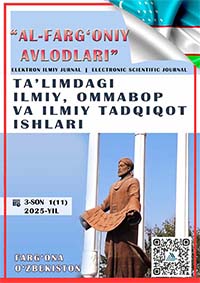CLASSIFICATION MODELS OF ARTIFICIAL INTELLIGENCE IN THE TRAINING OF PATHOLOGISTS
Keywords:
classification models, transfer learning, CNN architecture.Abstract
The article discusses the implementation of modern classification models of artificial intelligence in the training of pathologists. The software package "GistoDiagnozUZ" has been developed, including modules for preprocessing, segmentation and classification of histological images. Experiments on open and proprietary datasets have shown an increase in the AUROC value to 0.93, a reduction in the time for slide analysis by almost half and a decrease in the cognitive load of pathologists. The results confirm that the integration of transfer learning and original CNN architectures improves diagnostic skills and can become the basis for standardized AI support in educational programs on pathomorphology.
References
Bera, K., Schalper, K. A., et al. (2022). Artificial intelligence in digital pathology—new tools for diagnosis and precision oncology. Nature Reviews Clinical Oncology, 19, 744-757.
Wilbur, D. C., et al. (2022). Entrustable professional activities for pathology residents in the era of AI. Modern Pathology, 35, 1630-1638.
Mercan, E. (2023). Artificial-intelligence competencies for pathology training programmes. JAMA Network Open, 6(3), e2254321.
College of American Pathologists. (2021). Artificial Intelligence Principles for Pathology and Laboratory Medicine (White Paper).
Taylor, P. (2020). Global shortage of pathologists: AI may close the gap. The Lancet Oncology, 21(4), 466-467.
Litjens, G., Kooi, T., et al. (2017). A survey on deep learning in medical image analysis. Medical Image Analysis, 42, 60-88.
Ronneberger, O., Fischer, P., & Brox, T. (2015). U-Net: Convolutional networks for biomedical image segmentation. In MICCAI 2015 (pp. 234-241). Springer.
Tan, M., & Le, Q. V. (2019). EfficientNet: Rethinking model scaling for convolutional neural networks. ICML 2019 Proceedings, 97, 6105-6114.
Tellez, D., et al. (2019). Quantifying the effects of dataset size, data variability and transfer learning on deep learning performance in histopathology. Histopathology, 75(6), 914-924.
Borkowski, A. A., Bui, M. M., Thomas, L. B., Wilson, C. P., DeLand, L. A. and Mastorides, S. M. Lung and colon cancer histopathological image dataset (lc25000). // arXiv preprint arXiv:1912.12142. – 2019.
Naren O.S. Multi Cancer Dataset, Kaggle, [online] Available: https://www.kaggle.com/datasets/obulisainaren/multi-cancer.
Additional Files
Published
How to Cite
Issue
Section
Categories
License
Copyright (c) 2025 Farxod Meliev, У.Р. Шадиев, Ф.М. Мелиев, З.А. Маликов

This work is licensed under a Creative Commons Attribution 4.0 International License.












